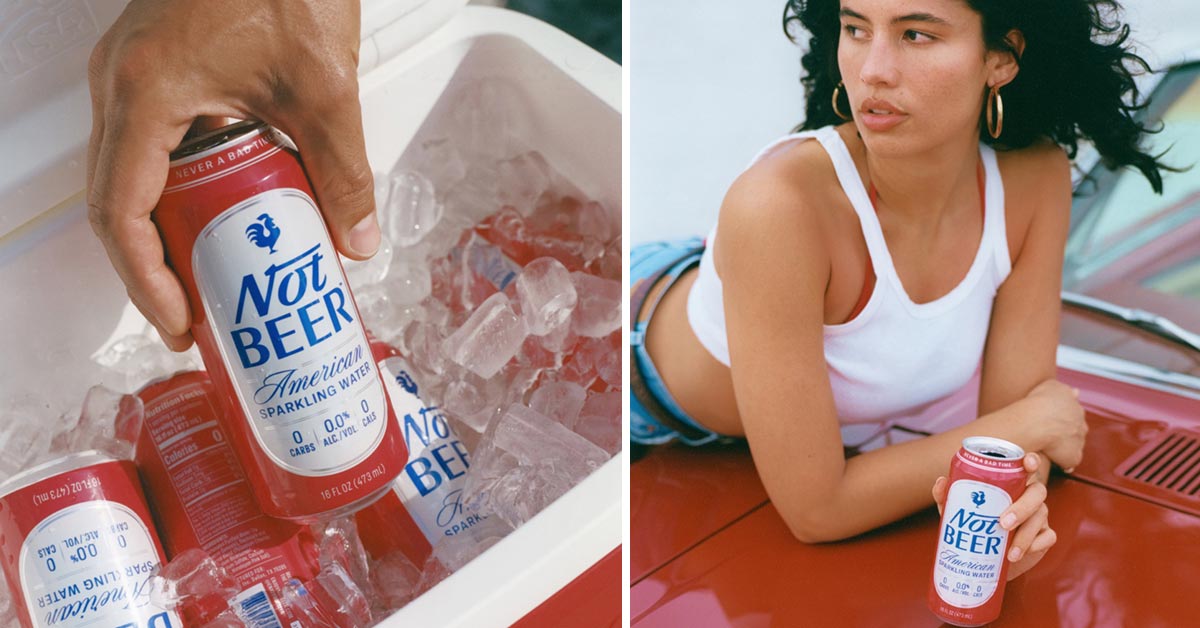Helped in no small part by the runaway success of Liquid Death, single-serve aluminum cans have become a hot format for water in recent years, attracting the likes of Perfect Hydration, Monster (Tour Water) and smartwater. But while co-founder Dillon Dandurand acknowledges Liquid Death’s appeal as an alcohol alternative, his brand aims to make that relationship and positioning even closer by calling out the contrast in the most obvious way possible.
Why describe water as “not beer,” you may be asking? Statistics, for one: according to a recent survey from NCSolutions, over one-third of Gen Z consumers (34%) say they’re more likely to try a new beverage product if it’s aligned with the sober curious lifestyle, compared to 17% of all Americans.
More specifically for Dandurand, co-founder of lupini bean food brand Brami, the name first and foremost reflects a fracturing beverage market where changing consumer preferences have sparked a wave of sometimes confusing or contradictory innovations. He recalls finding early inspiration on a billboard in Dallas for low-ABV beer Bud Light Next, touting its zero-carb credentials.
“At the time I thought it said ‘zero carbs, zero alcohol beer,’” Dandurand said. “And so I tell my friend, ‘What are we doing here? We drink beer for the alcohol, and there’s no alcohol in this product. Beer is made from carbs, and there are no carbs in this product. So what is this, and at what point is this no longer beer?’”
Take out the beer flavor, he argued, and the result is just water and definitely “not beer,” but that’s not what alcohol companies are selling, either. As Liquid Death has shown, canned waters have proven particularly effective in engaging and including non-alc drinkers in venues where alcohol traditionally dominates, like concerts and events; Live Nation is an investor and major partner. But Not Beer’s marketing approach is considerably less gory and grungy: the branding intentionally invokes familiar domestic beer packaging (calling out “0.0% Alc/Vol” on the front), and is earnest rather than sarcastic: “Never a bad time” is the tagline.
Seeing as how the liquid itself is straightforward — reverse-osmosis carbonated water infused with minerals and electrolytes, packaged in American-made aluminum cans — Not Beer will be leaning heavily on its branding and design to attract shoppers. The product is launching on Amazon today in 8-packs priced at $19.99 each.
“We don’t drink booze for the taste, we drink it for the feelings, and not just the feeling of being drunk,” said Dandurand, who compared Not Beer’s comedic approach to Budweiser’s “playful, carefree” ads from the late 1990s and early 2000s. “The alcohol companies sell us that fantasy world and I think one of the most important things in that is inclusion. It’s taking that alcohol marketing and applying it to an everyday drink.”
Not Beer isn’t the only water brand looking to get a piece of the action. Monster’s aforementioned Tour Water in 19.2 ounce cans (still and sparkling) was a limited item directed specifically at concerts and events before launching broadly in 2023, while Langers Juice acquired tongue-in-cheek startup GEN Z Water just over a year ago. Having staked its claim to hard seltzer, White Claw is also eyeing expansion in non-alc with its line of flavored zero-proof seltzers. Most notably, having recently closed a funding round at a valuation of around $1.4 billion, Liquid Death is not going anywhere anytime soon.
For Dandurand himself, Not Beer represents a long-awaited move into independent entrepreneurship, an interest sparked in part by his parents Curran and Jeff, creators of luxury men’s skincare brand Jack Black. The founder remains involved with Brami as a stakeholder and a part-time consultant, but his focus is on the new company.
“I like to be dynamic,” he said. “So never having a set plan of ‘this is what we’re gonna do.’ You take inputs that you get, and then you adapt your plan according to those new data points and you stay nimble so you can build the best strategy based on the most recent data.”
